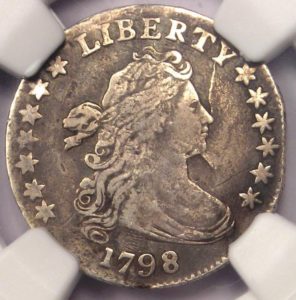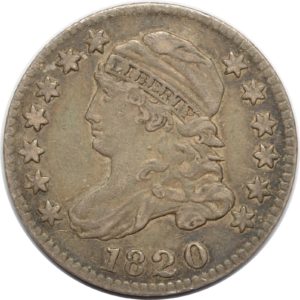Draped Bust and Capped Bust Dime


The dime may be an essential part of the U.S. decimal coinage system but it was one of the last coins that were issued by the U.S. Mint when the first operations began.
This is why, by the time the Draped Bust made its debut, copper cents and half cents have already been minted for 3 years, silver dollars and half dollars and half dimes for two years, and two gold coins—half eagle and the eagle—have been struck for a year.
Draped Bust, Small Eagle (1796-97)
The Draped Bust Small Eagle dime features a portrait of Liberty. She was designed by chief engraver Robert Scot with a neckline covered with drapery and her flowing hair tied by a ribbon. Stars surround her, with LIBERTY and the date inscribed above and below her, respectively.
The number of stars varied for different years.
1796 pieces of the Draped Bust featured 15 stars that represented the then 15 states in the Union. Dimes that were struck in 1797 have 16 stars following the addition of Tennessee. When the Mint abandoned the idea of adding a star for each new state, only the 13 stars were retained which symbolize the original 13 states.
On the other side of the coin is a small eagle, with wings spread and perched upon the clouds. It was surrounded by palm and olive branches. The motto UNITED STATES OF AMERICA encircled the eagle. Since the Mint Act of 1792 only required the denominations to be inscribed on the copper cent and half-cent, the Draped Bust half dime didn’t bear any mark of the denomination.
Capped Bust, Large Diameter (1809-1828)
The era when the Capped Bust dime was minted favored Rubenesque beauty and was evident in how German-born John Reich, second engraver of Chief Engraver Robert Scot, designed Liberty. Her design was three times more streamlined than the previous ones. She was also more stout and ample-bosomed, which led to U.S. Mint writer William Ewing DuBois calling the Capped Bust Liberty “Reich’s fat German mistress”, half a century later.
The reverse side featured an American Eagle with the head turned left. It held three arrows and an olive branch that symbolize strength and peace, respectively, and the Union Shield on its breast.
Although the Capped Bust dime was in production, it was not continuous. But there were over 5 million pieces minted in all.
Capped Bust, Small Diameter
In 1828, the Capped Bust, Small Diameter was introduced. It was the same year that Andrew Jackson became president. During a 9-year period, the reduced size dime was struck, with approximately 6,730,000 pieces produced. This excludes proofs that were added for each year.
The reduced size was a result of the Mint Act of 1792 that require minted coins to follow the same standards and the introduction of newly designed equipment that allowed planchets to be struck.
There were several interesting varieties of the Capped Bust with a small diameter. One type featured an overdate (1830/29), and another with the base of the number 2 on the date sporting a curled base.
These unique features make coin collecting today just as interesting because they become elusive above Mint State-64.
